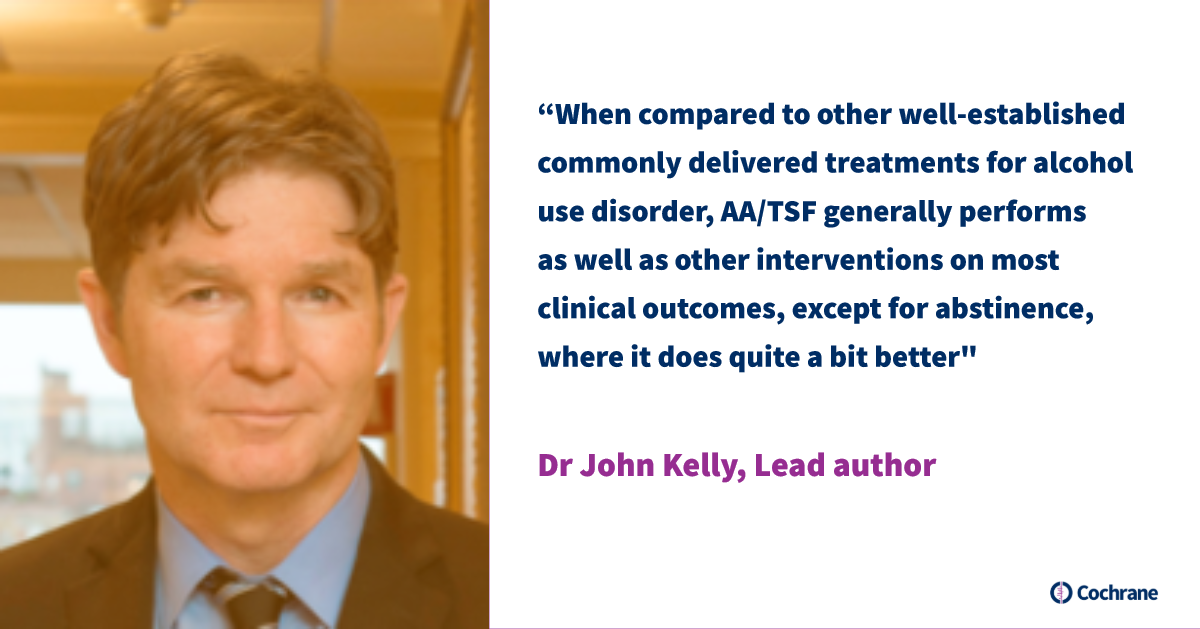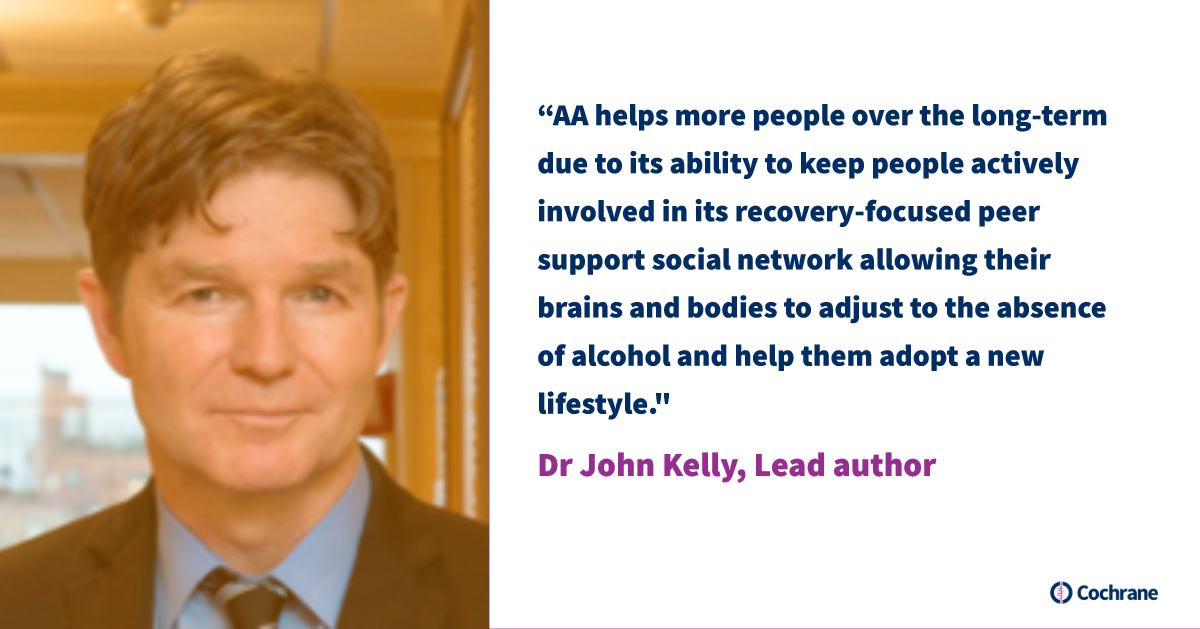
Dr John Kelly, Elizabeth R. Spallin Professor of Psychiatry in the Field of Addiction Medicine, Harvard Medical School; Director, Massachusetts General hospital (MGH) Recovery Research Institute tells us about this updated Cochrane review.
What was the aim of this Cochrane review?
The aim of the review was to determine the clinical and public health benefits attributable to Alcoholics Anonymous and related 12-step Facilitation Treatments (TSF) designed to proactively link patients to AA, in helping people achieve remission from alcohol use disorder and improve their functioning and well-being.
Why is it important?
It is important because alcohol use disorder is a major cause of misery, premature death, and disease worldwide, killing ten times more people than all illicit drugs combined. AA is one of the most ubiquitous and popular sources of help for alcohol use disorder so it is important to determine the degree to which it may be helpful when evaluated against the most rigorous scientific standards available, as in the Cochrane Collaboration.
There has been a great deal of confusion and misinformation about the state of the science on AA so we felt it was important to clarify the evidence using the highly structured and rigorous review criteria inherent in the Cochrane system.
Included in this review were more than twenty randomized controlled trials that compared AA/TSF interventions to other well-established active treatments like cognitive-behavioural interventions and motivational interviewing type treatments. Also, because AA is free and widely available, we wanted to examine the potential health care cost-benefits of implementing AA/TSF treatments relative to other more well-researched treatments to determine whether there may be savings to health care systems if they were to implement treatments that linked patients to AA.
This is an update of a review published in 2006. What has changed?
The prior review published in 2006 was based on only 8 studies and included just a few thousand participants. The quality of the evidence at that time was not strong. This updated review is based on 27 rigorous comparative investigations and included around 11,000 participants, as well as economic analyses. Thus, both the quantity and quality of the research has increased substantially in the intervening years prompting this new summary.

What are the conclusions the authors have been able to draw?
When compared to other well-established commonly delivered treatments for alcohol use disorder, AA/TSF generally performs as well as other interventions on most clinical outcomes, except for abstinence, where it does quite a bit better - particularly true for helping many more patients achieve sustained abstinence and remission. The review also found that AA/TSF reduced health care costs substantially while simultaneously improving patient’s abstinence relative to other treatments.
The quality of the evidence for the abstinence and economic outcomes was moderate to high indicating there is generally a high degree of confidence that can be placed in these new findings.
What can practitioners take from this review?
When treating patients with alcohol use disorder, AA/TSF interventions should be a frontline treatment option to be implemented in countries where AA is available. Implementing TSF interventions along the lines of those tested in this review is very likely to result in improved alcohol use disorder treatment outcomes and substantially lowered use of health care resources that saves money.
What can people seeking help for recovery from alcohol abuse learn from this Cochrane review?
Findings have important implications for people suffering from an alcohol use disorder in that there is a free, community-based, option in AA that can really help people to stop drinking and achieve lasting remission and recovery. One important finding from this review was that it does matter what type of TSF intervention people receive - better organized and well-articulated clinical linkage treatments resulted in the best outcomes. In other words, it is important for clinical programs and clinicians to utilize one of the proven manualized interventions to maximize the benefits attainable from AA participation.
Research into freely available, community-based, recovery support resources, such as AA, was once considered nearly impossible, in recent years researchers have found creative methods of evaluating AA carefully and objectively. However what further research is needed?
The last 25 years has seen a rapid expansion in the growth of studies on AA and TSF clinical interventions designed to proactively link patients with AA. The culmination of this body of work has shown that AA can be studied and subjected to the same scientific standards as other interventions proving itself effective at helping people suffering from alcohol use disorder achieve sobriety and lasting remission all at a reduced health care cost.

These superior benefits makes sense when alcohol use disorder is viewed as a chronic illness, which for many is susceptible to relapse over months and years; one of the reasons why AA helps more people over the long-term is through its ability to keep people actively involved in its recovery-focused peer support social network over these long periods so that their brains and bodies can adjust to the absence of alcohol and the demands of recovery and help them adopt a new lifestyle that is more conducive and supportive to long-term stable remission and enhanced quality of life.
It is important to note, however, that some countries do not have AA as available as some other nations and some patients will not attend AA for various reasons despite being clinically facilitated to attend. Thus, while AA can be a valuable asset where it exists, it is important to remember that it is not suited to everyone and we need to have a variety of options available for people suffering from the range of alcohol problems and severities of alcohol use disorder. Such alternatives can take the form of medications like naltrexone and acamprosate, other ongoing professionally-delivered therapies like cognitive-behavioural counselling, and other recovery specific peer-support organizations like SMART Recovery, LifeRing, and Women for Sobriety. These other peer-based organizations await additional research to demonstrate their helpfulness but they look very promising as well.
For now, I think of AA as the closest thing in public health that we have to a free lunch - it is effective, cost-effective, and freely available. The findings are good news for sufferers and their families and, given the economic burden of alcohol use disorder in most middle and high-income countries, its availability is also good news for health care systems and national economies.
- Read the full Cochrane systematic review
- Learn more about Cochrane Drugs and Alcohol
